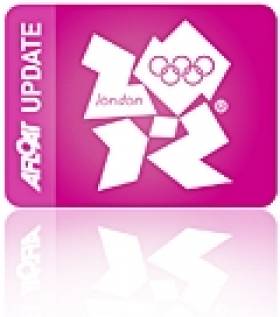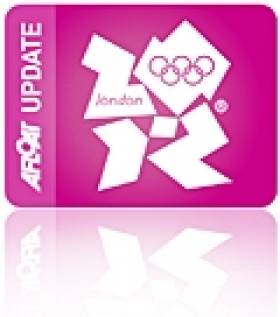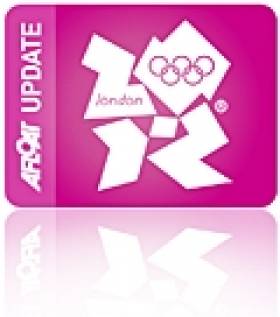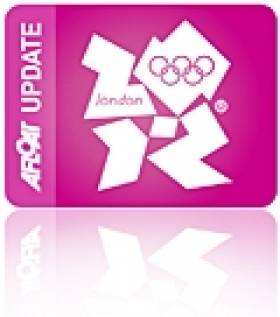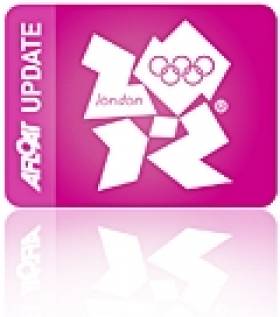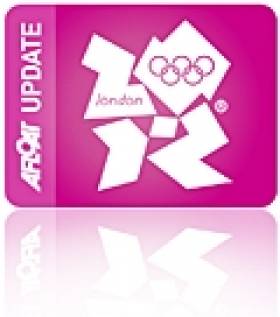Displaying items by tag: Olympic
Perth Serves up a Tight Finish for O'Leary and Burrows
#PERTH 2011 – Missed opportunities on a crucial day afloat in the Star keelboat means Olympic qualification for Ireland's Peter O'Leary and David Burrows now goes 'to the wire'. Disappointingly, the pair scored a 16th and a 24th today in a fleet of 41 and slip to 15th overall. It follows a black flag result on Tuesday. The top 11 nations will qualify for the Olympics in Perth and although O'Leary/Burrows are in the qualification zone, they will be well aware they occupy the last nation slot. The Cork-Dublin duo have been leapfrogged by the Swiss and now share the same overall score as Spain's Fernando Echavarri and Fernando Rodriquez on 97 points each with only one day of racing left before the medal race on Saturday.
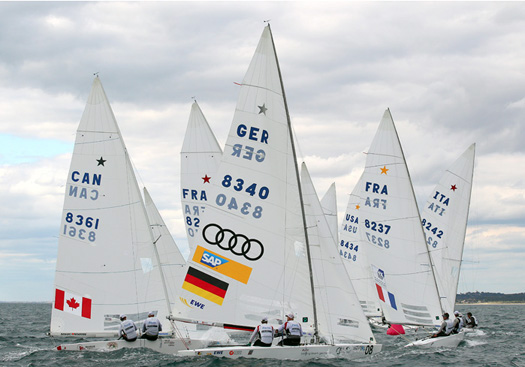
Tight racing in the penulitmate rounds of the Star champs in Perth. Photo: Richard Langdon
The Star class have a rest day tomorrow with their final day of fleet racing taking place on Friday.
Irish Skiff Pair Qualify for London Olympic Games
#PERTH 2011 – Belfast pairing Ryan Seaton and Matt McGovern are on their way to the London Olympic Games thanks to another solid performance in Perth today in the crucial closing stages of the 49er World Skiff Championships. It's Ireland's second successful qualification result at the ISAF World Championships. Last week Annalise Murphy became the first Irish sailor through. The pair who been recording impressive results in the breezy championships currently lie 10th overall and seventh country. Seaton and McGovern took two fifth places today to take Olympic qualification with ease.

Ryan Seaton and Matt McGovern from Ireland have qualified for the Olympics in the 49er class today. Photo: Richard Langdon
The 67– boat fleet now splits into Gold and Silver fleets with the top 25 boats entering the Gold fleet. Racing will continue through to Saturday with the top 10 teams then continuing on to the medal race on Sunday.
Fourteen London 2012 49er spots were available at Perth 2011 and after eight races the 14 places have been decided. Australia, Austria, Croatia, Denmark, Spain, Finland, France, Germany, Ireland, New Zealand, Poland, Portugal, Sweden and the USA will all be on the starting line at Weymouth next year.
Croatia's Pavle Kostov and Petar Cupac made the gold fleet by six points ahead of Steve Thomas and Jaspar Warren (AUS). They take the last qualification spot and if selected will compete at their second Olympic Sailing Competition after their 17th place finish at Beijing 2008.
Five more 49er spots will be available at the 2012 World Championship in Zadar, Croatia from 4-13 May 2012.
Book Your Berth for the Olympic Regatta
#WEYMOUTH – Applications for booking visitor berthing in Weymouth Harbour and anchorage in Weymouth Bay during the sailing events of the London 2012 Olympic and Paralympic Games are now open.
It will not be possible for visiting boats to enter Weymouth & Portland Harbours and expect to be accommodated during Games time without pre booking their berth or anchorage. It is essential therefore that bookings are made in advance, as it is expected that all available berths and anchorages will be fully booked, well before the start of the Olympic Games.

Weymouth and Portland Harbours will still be accessible at all times during the Games, via a dedicated channel and will continue to operate as working harbours for ferry services to the Channel Islands, commercial shipping, fishing, diving and other recreational water based activities. There will however be restrictions on the waters within Weymouth Bay and Portland Harbour where the race areas are located, (known as the field of Play) during race times themselves.
Olympic sailing will take place between 28 July and 12 August 2012 Paralympic sailing will take place between 29 August – 6 September 2012
Over the last 18 months the Weymouth Harbour team has been working hard to ensure that boat owners who come to Weymouth & Portland in summer 2012 enjoy the unique experience of visiting the waters around the Olympic sailing events.
There will be plenty going on during the summer of 2012, including the free 'Live Site' on Weymouth Beach, where the sailing and other Olympic sporting events will be screened, the Weymouth Bayside Festival, which will host exhibitions; Dorset products, catering and entertainment, together with a 12 week programme of local cultural events called the 'Maritime Mix'; part of the London 2012 Cultural Olympiad Festival.
Peter Mole Weymouth Harbour Master, said: "We can start to share the excitement and feeling of anticipation with those who will be joining us for this once in a lifetime experience. Improvements are being made to services around the harbour, including new showers, extra pontoons, pump out facilities, Wi-Fi and a water taxi serving the 2012 anchorages out in the Bay.
"The Weymouth Harbour team look forward to welcoming boating visitors to view the Olympic races talking place in some of the finest sailing waters in the world with the beautiful backdrop of the Jurassic Coast World Heritage Site. However all prospective visitors need to be aware that there will be restrictions during Games times and that for capacity and security reasons, all berthing and moorings in the harbour must be pre-booked."
49er Duo Stay on Course for Qualification
#PERTH 2011 – Light winds did 49er pair Ryan Seaton and Matt McGovern no harm in Perth today. The Irish pair scored a 7th, 11th and 12th in their three races and now lie 15th overall. It was not as spectacular as their opening day but the consistent scores keeps the duo on track for Olympic qualification. A further three days of racing will take place for the 49er class before the medal race on Sunday. The top 14 nations will earn their place at London 2012. Seaton and McGovern are currently eighth nation.
After a hard day of dramatically fluctuating winds and more than 10 capsizes in the racing, Denmark’s Peter Kruger Andersen and Nicolai Thorsell are the overall leaders at the end of the second day of competition for the 49ers at the ISAF Worlds.
Erik Storck and Trevor Moore (USA) finished first in race 4 for the Yellow fleet, crossing the line 21 seconds ahead of Santiago Silveira and Philipp Umpierre (URU), who placed second.
Race five saw Allan Noerregaard and Peter Lang (DEN) win comfortably with David Evans and Edward Powys (GBR) second and Storck and Moore with another good race in third place.
After a complicated start with several boats called back to the line, Kruger Anderson and Thorsell (DEN) took out the sixth race a massive 101 seconds ahead of Jonathan Ladha and Daniel Inkpen (CAN), with Storck and Moore again in third place.
The first race of the day for the Blue fleet saw wind speeds soar to 23 knots in the last leg of the race which allowed Australia’s Nathan Outteridge and Iain Jensen to maintain the lead for the entire race, crossing the line 42 seconds ahead of Emil Toft Nielsen and Simon Toft Nielsen (DEN).
Outteridge and Jensen had another win in race 5, with the Nielsen brothers once again finishing shortly behind by a mere 11 seconds.
Wind changes caused huge dramas in the last race of the day resulting in constant course alterations, but this did little to hinder Stephane Christidis and Emmanuel Dyen (FRA) who crossed the line first, 21 seconds ahead of Will and Sam Phillips (AUS).
Favourites to win the last race, Outteridge and Jensen struggled from the start and ended up finishing 13th.
The 49er competition is scheduled to continue on Wednesday from 1200 local time on the Owen course.
Black Flag Setback for O'Leary/Burrows in Perth
#PERTH 2011 –There has been a setback to the Peter O'Leary and David Burrows Star keelboat campaign today following their disqualification from the sixth race when the Irish crew were lying second.

Star keelboats line up for a world championship start in Perth. The Irish Star was judged to be over the line in race six. Photo: Richard Langdon
It means the pair are now in a real fight to secure Olympic qualification. The top 11 nations will qualify for next year's Olympic regatta and the Irish pair are currently 11th nation. Swiss, Italian, Greek and Croatian rivals are all vying for the final slot and can still overhaul the Irish boat.
The pair were pulled from the race by officials who judged them to have been premature starters in race six. The subsequent disqualifcation drops them to 14th overall as they must now count the 33rd placing scored in race four.
After five races sailed the Dublin-Cork combination were only one point off third overall earlier today.
A post on the team facebook page today simply says:
Simpson said: "We had an okay run, but Iain hurt his back and was in tears. It looks like it's his lower back, but we don't know yet. No way could we have raced the second race."
"It's frustrating; sadly this is the second event in a row Iain has injured himself. He injured his ankle last time," he said. "I guess we won't be sailing, but we never rule anything out."
Shortly after the race, Percy said on his Twitter account: "My back fully went today half way through the first race. Unfortunately the end of the championships and the beginning of a few weeks of physio."
On the penalty that ended their race, Simpson said: "Sadly we picked up a yellow flag and we don't know why – we're still confused."
Race 5 was won by Mateusz Kusznierewicz and Dominik Zycki (POL), who led for the entire course.
Closely behind in second place were Robert Scheidt and Bruno Prada (BRA), well clear of the third placed German team, Johannes Polgar and Koy Markus.
In the sixth race, Scheidt and Prada had to settle for another second place after crossing the finish just two seconds behind Swedish pair Fredrik Loof and Max Salminen.
Finishing in third and with only one second separating them from the Brazilians were Kusznierewicz and Zycki.
After six races, Scheidt and Prada move into first position overall. Mendelblatt and Fatih (USA) and Kusznierewicz and Zycki (POL) trail the Brazilians by only one point.
O'Leary and Burrows Lie a Single Point off Third
#PERTH2011 – Keelboat pair Peter O'Leary and David Burrows are in a three way tie vying for third place overall after five races sailed at the Star world Championships in Perth today. The sole Irish contenders in the 42-boat fleet scored 11th in race five to put them on equal points with Brazil's Robert Sheidt and Poland's Matseix Kusznierewicz, former Olympic Gold medallists from the Laser and Finn classes respectively.
O'Leary, Schedit and Kusznierewicz all share 24 points, just one point shy of America's Mark Medendlatt and Brian Faith in the Bronze medal position. Although the Irish crew are shown sixth on the leaderboad after a single discard has been applied it could not be tighter as the event moves past the half way stage today. Race six results as we have them.
49er Duo Seaton/McGovern Start Solidly in Perth
#PERTH2011 – Ireland's Ryan Seaton and Matt McGovern are at the top of the 49er high performance dinghy fleet in Perth today having finished second, fourth and 11th in the first three races of their World Championshipsto be fifth overall. It is a solid start for the Belfast duo who hope to qualify for the Olympic regatta this week. 14 nations will qualify in the 49er fleet for the Olympics in London.
Denmark's Jonas Warrer and Soeren Hansen (DEN) and Peter Burling and Blair Tuke (NZL) are the joint overall leaders after the opening day of 49er racing on Monday.
Warrer and Hansen comfortably finished first in race one on Monday for the Yellow fleet by 85 seconds from Denmark's Peter Andersen and Nicolai Thorsell, who placed second.
John Pink and Rick Peacock (GBR) dominated in race two but only managed to finish six seconds ahead of Emil Toft Nielsen and Simon Toft Nielsen (DEN).
Tobias Schadewaldt and Hannes Baumann (GER) took out the third race, only just beating New Zealand's Burling and Tuke, while Pink and Peacock (GBR) finished a disappointing 16th after their win in the previous race.
"The first two races were really good until the boat capsized. That delayed us," Peacock said. "It took us a while to get the boat back up. After that mishap, we bounced back. Overall, I'm impressed with how we raced."
In the Blue fleet, David Evans and Edward Powys (GBR) lead for most of race one, finishing first by 13 seconds ahead of McGovern and Seaton (IRL).
Stephane Christidis and Emmanuel Dyen (FRA) won race 2, while Erik Heil and Thomas Ploessel (GER) were second.
World number one duo Nathan Outteridge and Iain Jensen (AUS) finally showed some of their best to win the last Blue fleet race of the day. Noe Delpech and Julien Dortoli (FRA) were second. The Australians are tenth overall.
The 49ers are scheduled to continue racing on Tuesday at 1200 Perth time on the Owen course.
Elsewhere, In the men's Laser class James Espey, also from Belfast lough, is lying 56th in the 147 strong fleet having scored an 18th and 22nd in the two races of the day. The first 35 nations will qualify for the Olympics at this event.
The three-time Laser champion and 2010 ISAF Rolex Sailor of the Year, Tom Slingsby (AUS), swamped the field in the opening race of the day but made an uncharacteristic error in the second to finish sixth with the mistake costing him top spot on the leaderboard.
Slingsby has seven points after the first day of Laser racing, one behind Blue fleet's Jesper Stalheim (SWE).
"I guess it was my fault, I should have looked where the top mark was," Slingsby said. "I tacked off the line, went for a few minutes, then tacked back and was over-laid by a long way, hundreds of metres. I rounded in the high teens or low twenties and was able to pull to six.
"All in all I didn't have a drop today and that was the goal, I'm in the hunt."
Slingsby was 35 seconds clear of Kacper Zieminski (POL) in race one with Sweden's Rasmus Myrgren a further 30 seconds back. Australia's Ashley Brunning finished the day with two fourths to put him equal third overall.
Poland's Karol Porozynsky scored a fifth and a second to lead the Red fleet with seven points from Germany's Simon Grodeluschen on eight points with a seventh and a win.
The Yellow and Blue fleets raced in 13-16 knot winds while the Red fleet had consecutive races in the late afternoon with 17-22 knot winds under a leaden sky and frequent lightning flashes.
Laser racing is scheduled to continue on the Parmelia course from 1200 local on Tuesday.
Racing continues until Sunday 18 December 2011.
Third Place in Race Four Keeps O'Leary/Burrows in Top Ten
#PERTH2011–Peter O'Leary and David Burrows are back in the top ten of the ISAF Star World Championships in Perth today after briefly dropping to 13th from fifth overall, the result of a poor third race where they scored 33rd in their 42-boat fleet. They scored an excellent third place though in the second race of the day to put the sole Irish pair ninth overall on 46 points, the same tally as Portugal's Afonso Domingos and Frederico Melo in eighth.
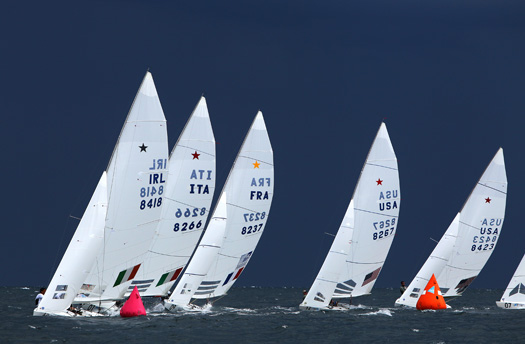
Leading the world - the Irish Star rounds the top mark first. Photo: Richard Langdon
Writing on their facebook page the Irish crew said: '
Another outstanding performance from the British Olympic Champions Iain Percy and Andrew Simpson consolidated their first place position in the overall standings after race four in the Star fleet.
Percy and Simpson have a total of 16 points while Mark Mendelblatt and Brian Fatih (USA) are on 28 points, with Germany's Robert Stanjek and Frithjof Kleen just behind them on 30.
"We had a good day today. We weren't going very well but we hung in and fought hard," Percy said. "My body is a bit bruised and battered for it but it's okay".
In race three, Norwegian team Eivind Melleby and Petter Morland Pedersen took first followed closely by Aimilios Papathanasiou and Antonios Tsotras of Greece.
The fight for third was close with Aimilios Papathanasiou and Antonios Tsotras of Greece just making it, putting Germany's Johannes Babendererde and Timo Jacobs in fourth place.
The outcome of race four saw the Swedish pair Fredrik Loof and Max Salminen take first place followed by Brazil's Robert Scheidt and Bruno Prada.
Third went to O'Leary and Burrows while British pair Percy and Simpson were fourth.
With six more races until the medal race the British are aware of the obstacles to come.
"There is still a long way to go, we're not super quick, so not confident we will get too far but we will keep battling to the end," he said.
Star racing is scheduled to continue on Tuesday on the Leighton course from 1300 Perth time.
O'Leary and Burrows Straight into Third Place
#PERTH2011 – Ireland's Peter O'Leary and David Burrows have sailed straight to the top of the Star keelboat leaderboard after the first day's racing of the ISAF world Championships today. The Cork-Dublin pairing are third overall having counted an 8 and 2 in the 42 boat fleet and just three points off leaders, the current Olympic Gold Medallists Iain Percy and Andrew Simpson from Great Britain.
The Irish Stsr boat is out of the water this evening having damage repaired after a second race collision, O'Leary and Burrows are working on the basis that all should be good by tomorrow for the important third race of the series.
Latest results here
Ainslie Goes Overboard in Perth
#PERTH2011 – British Olympic poster boy Ben Ainslie has been disqualified from both of today's Finn races in Perth, dashing any chance of a much sought after world title in the run up to the Olympics.
The three time Olympic Gold Medallist Ben Ainslie (GBR) boarded a media RIB covering the Perth 2011 ISAF Sailing World Championship and Ainslie is alleged to have 'grabbed' a cameraman.
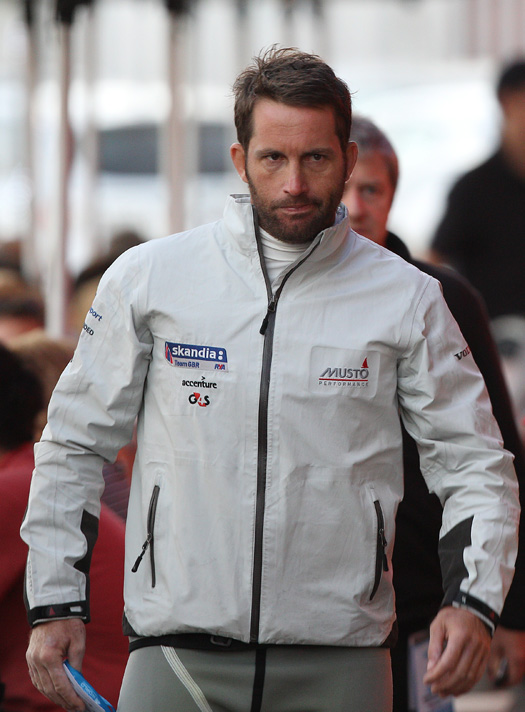
Ben Ainslie ashore in Perth - Photo: Ocean Images
An ISAF press statement just released says:
"Following today’s incident with Ben Ainslie (GBR), a hearing was heard by the International Jury under Racing Rules of Sailing 69.".
The International Jury’s decision is: GBR 3 is to be scored DGM for Races 9 and 10.
This means that Ainslie is disqualified from Races 9 and 10 and those scores cannot be excluded.
Britain's sailing superstar had just finished second to Dutch sailor PJ Postma in the first race of the day.
The Perth Now website says a 'confrontation' on board the media boat arose because Ainslie had been angered by the media boat creating a wash that aided a rivals.
He jumped from his craft, swam to the media vessel and climbed aboard.
After the incident Ainslie dived off the bow of the RIB and swam back to his abandoned dinghy.
Photographer Mick Anderson captured the incident.
The whole sequence of pictures can be seen here
Perth Now has more on the story here as has The Telegraph here
Comments from the British Camp:
- Stephen Park, RYA Olympic Manager:
Clearly this is a disappointing position for Ben and of course for the team. It's particularly disappointing bearing in mind that all parties that spoke at the hearing all effectively said exactly the same thing. Everyone accepted that there was fault on both the side of the television production crew and indeed on Ben's side. Unfortunately because of the situation we were in, with the sport trying to move to better television images to appeal to that market, sometimes there's a learning process to go through from a television perspective and sometimes there are implications and this is an example of one of those.
Both parties, the television side and Ben have both apologised to each other and as far they're concerned we're ready just to go back out and get on with our respective jobs tomorrow.
It's particularly disappointing that this Championship has effectively been determined in this way in the jury room rather than between sailors on the water.
There have been various rumours in the media about Ben having 'assaulted' the driver of the boat. As far as we're concerned there wasn't an assault which took place, and as far as the driver was concerned that was part of his statement to the jury so we're pretty keen to put that to bed and recognised that that's a bit of over exaggeration and sensationalism.
While we accept the penalty from the jury and do not condone Ben's behaviour, i would hope, on the basis of the jury's facts found, that it is recognised that lessons need to be learned both from the side of the International Sailing Federation as organising authority as well as the sailors. At the moment the sport seems to be fumbling its way into trying to make the sport more appealing for television but surely there is a better way than trialling new race formats, rule regulations and specifically in this case media initiatives than trialling them at the World Championship which is arguably the most important event in the Olympic cycle outside of the Games themselves.
Ben Ainslie:
I overreacted to what I thought was a situation where I felt my performance was being severely hindered. I'm very thankful that everyone involved has taken it how it was - as something which was blown out of proportion in terms of what actually happened. We've all apologised to each other and are looking forward to moving on.
I'm obviously really disappointed with the decision. Unfortunately it's part and parcel of the sport trying to develop its area within TV and in a number of instances this week that line has been crossed and that's something which everyone has to accept is a development.
I'm very sorry that the jury decided to react the way they did over something which really wasn't as big as it was blown up to be. It's very disappointing that the Championship has been decided this way. I've worked extremely hard over the last six weeks and have been training incredibly hard to get to this position in a venue which has been difficult for me with my size against the bigger sailors. I feel like I've actually sailed one of the best regattas of my life so to be in this situation now is very disappointing but I certainly hope now that it's one of the British boats on top of the podium if it can't be me.




























